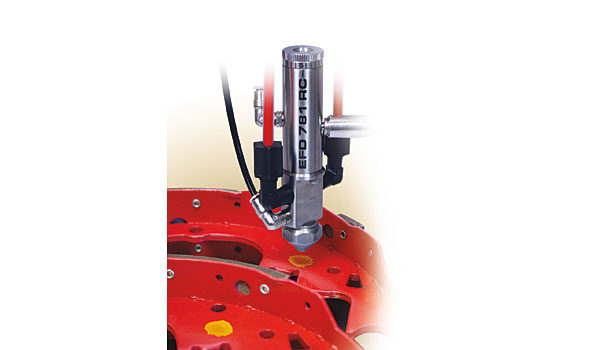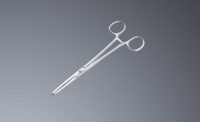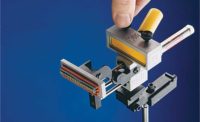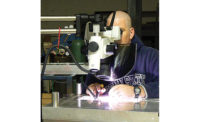The wave of automotive recalls this year underscores the importance of putting identification codes on products. Without such codes, consumers would not know if their vehicles were safe, and automakers would not know where or when problem parts were made.
Warranty requirements aren’t the only reason to put codes on products. Such codes help manufacturers track inventory, customize assemblies, “marry” subassemblies built on different lines, and ensure that the correct parts are installed in the correct products. Parts that are expected to wear can be identified with a code so customers can easily find replacements.
Even a simple dot can be practical. For example, assemblies passing certain tests or inspections can be marked with a dot to separate them from those that did not pass. Or, a dot can be placed on a part so that assemblers install it in the correct product, order or orientation.
Assemblers have many options for marking products. Some methods, including labeling, engraving, stamping, chemical etching and pad printing, contact the parts to be marked. Other technologies, such as ink jets, spray valves and lasers, are noncontact methods. Which to use depends on the materials, the production volume, environmental considerations, and what information needs to be marked.
Engraving and Etching
One way to mark products is to indent them. This can be accomplished in several ways.
The hand stamp is one of the simplest pieces of marking equipment. This tool is just a rectangular piece of metal with a character engraved on one end. To indent the character in an object, the engraved end is held against the object while the opposite end is struck with a hammer.
To automate the process, the stamp can be mounted in a press. Complex dies can automatically advance digits to create consecutive serial numbers.
Hot stamping is a variation on this process. The process is identical to impact stamping, except that the die is heated. This process is used to mark—and often, to simultaneously weld and seal—plastic parts. It’s also used to mark wire and cable.
Roll marking is another stamping variation. This process can be accomplished in several ways. A round part can roll past a flat die; a round die can roll across a flat part; or a round die can roll around a round part. Because a rolling die has a small point of contact with the part, less force is required to make a mark than a press.
In engraving, a tungsten carbide stylus draws straight and circular lines on the material. Dot peening is a similar process. Instead of writing on the material, the stylus cold-forms dots with a low-stress, compressive force. Both processes can be used to make bar codes, 2D codes, logos and alphanumeric characters of various sizes and depths. Straight, arced or radial inscriptions can be produced in soft or hard materials with flat or uneven surfaces.
In chemical etching, a silk screen and acid are used to burn shallow marks on metal parts. This method is only practical for repeating the same mark. Another limitation is that eventually the screen will wear out and require replacement. Also, assemblers must take extreme care when handling the acid.
Dry etching is done much the same way. Instead of acid, a fine abrasive grit is blown through a stencil. This process marks metals with hard, anodized or highly polished surfaces, such as bathroom fixtures or hand tools. It produces a frosted impression.
Ink Methods
If an assembler simply needs to put a dot on a product, an easy solution is a refillable, felt-tip marker mounted to a pneumatic cylinder. The cylinder advances the marking head to and from the part, and a pump supplies ink to the head every 10 to 20 marks. A typical instrument can mark 10,000 to 20,000 parts with 1 ounce of ink. Nibs range in size from 0.125 to 2 inches and can be circles, squares, rectangles or triangles.
A pneumatic spray valve can also apply small dots or stripes of ink or paint. A typical spray valve has two air inputs. Actuating air lifts the valve needle from its seat to start the flow of marking fluid. Then, low-volume, low-pressure air is used to spray a uniform amount of fluid on the substrate. At the end of the cycle, the needle seats with a fast, clean cutoff, and the low-pressure air continues for a few milliseconds. This prevents clogging by removing any residual fluid from the nozzle.
More complex markings require more complex solutions. One example is a pad printer. This type of system is used to print logos and other information on small plastic consumer products, such as mugs, pens, golf balls and toys. A basic system consists of horizontal and vertical slides, an open inkwell, a spatula, a blade, a printing plate and a silicone transfer pad.
To start the sequence, the horizontal slide moves left, and the spatula scoops ink out of the inkwell and over the plate. When the slide returns, the blade removes excess ink from the plate. The vertical slide then presses the transfer pad against the plate and lifts it back up. As the transfer pad—now holding the image from the plate—moves left toward the object to be printed, new ink is deposited onto the plate. The pad then descends to the part, leaves the imprint, and the process is repeated.
A variation of this system is rotary gravure pad printing. The process is the same, except that the printing plate and transfer pad are rotating drums. This type of system prints on cylindrical products, such as syringes and beakers.
For serial marking applications, an ink jet system is necessary. As its name suggests, an ink jet marks surfaces with a stream of continuously circulating ink. Inside the printhead, a fine jet of pressurized ink emerges through a small nozzle. A drop generator next to the nozzle contains a drive rod that creates ultrasonic pressure waves in the ink, making the jet break up into a stream of separate drops shortly after leaving the nozzle. An electrode below the nozzle gives each drop an electrostatic charge. The ink drops then pass through the electrostatic field created between two high-voltage deflector plates. The direction of flight of each charged drop varies with the size of the charge. Ink drops not required for printing are not given electrostatic charges and are collected in a gutter to be recycled.
With an array of ink jets, assemblers can print small, high-resolution graphic images or several lines of information over a wide area.
Regardless of the application method, assemblers have many choices for inks. Inks range from water-soluble formulas that are easily removed, to permanent varieties that withstand caustic chemicals. Inks can air-dry, or they can be cured with heat or UV light. When visible marks aren’t suitable, UV-sensitive inks can be used. These inks are invisible in normal light, but fluoresce when exposed to UV light.
One concern with ink-based marking methods is the ink’s ability to adhere to the substrate. In some cases, parts may have to be cleaned or treated with a plasma or chemical that promotes adhesion.
Labeling
Labels are a popular method of bar coding products. However, for labeling to be a viable option, assemblers must first ensure that the labels will survive subsequent manufacturing processes, as well as operation of the finished product.
A wide variety of label materials and adhesives is available. Polyester and vinyl labels can be used when high temperatures and harsh chemicals are not a concern. High-temperature Kapton is recommended for printed circuit boards because it can withstand wave and reflow soldering. Vinyl and nylon cloth labels are recommended for tubing, wiring and cables. Metallized polyester labels can be an alternative to metal rating plates on electrical equipment.
If labels are an option, assemblers must then decide whether to use preprinted labels or to print them on demand on the line. Preprinted labels are used when the information to be encoded is known ahead of time. If the application simply requires serial numbers, there may be no reason to become involved with the organization and programming required to prevent duplicate numbers and other errors.
On the other hand, the information to be printed on the label cannot always be determined ahead of time. In that case, a print-and-apply system is required. These systems allow information to be generated at the time of labeling and applied to the product. They typically have software that lets assemblers design their labels on a computer screen. A key advantage of these systems is their ability to accommodate small production runs.
However, print-and-apply systems are more expensive than using preprinted labels. Besides the cost of the printer, such a system may require an additional bar code scanner to verify that what has been printed is correct and scannable.
Label applicators can be fixed-axis, two-axis or three-axis machines. If the label will be placed in exactly the same position on every product, a fixed-axis machine is adequate. For multiple label positions or for high-mix production, a multiaxis machine is necessary.
Label placement methods vary. Some applicators apply a label by lightly hitting or tamping the product as it passes. Others blow or lightly brush the label onto the product. Placement accuracies also vary, depending on the product and the size of the label.
Laser Marking
Lasers are the most flexible marking technology, producing permanent, high-quality marks on metals, alloys, paper, rubber, glass, plastics, composites and ceramics. They can make bar codes, 2D codes, serial numbers, logos and graphics on flat, curved and irregular surfaces. Lasers are used to mark such products as integrated circuits, printed circuit boards, medical devices, calipers and computer keyboards.
Several plastics have been formulated to work with laser marking equipment. These plastics change color when exposed to the focused heat of a laser. For example, a laser can produce bright white marks in some grades of black acetal copolymer. The laser creates the mark by melting and foaming the surface of the polymer. By adjusting the frequency and power, the amount of foaming can be controlled, so the color of the marks can be made lighter or darker. The markings on trunk-release levers and radio buttons in many cars are produced this way.
Nd:YAG, helium-neon, CO2 and excimer lasers can be used for marking. With a dual deflection head and a programmable beam splitter, a single laser can simultaneously mark two parts with the same information. Alternatively, the same system can mark a larger area without moving the part or tray of parts. A typical laser can produce more than 400 single-stroke characters per second.
There are safety concerns with laser marking. In some cases, the laser must be housed in an enclosure with interlocking doors. Windows in the enclosure must prevent the laser light from escaping. Laser marking can also generate fumes, but these can be removed with an exhaust unit equipped with HEPA and charcoal filters.
ASSEMBLY ONLINE
For more information on parts marking, visit www.assemblymag.com to read these articles:










